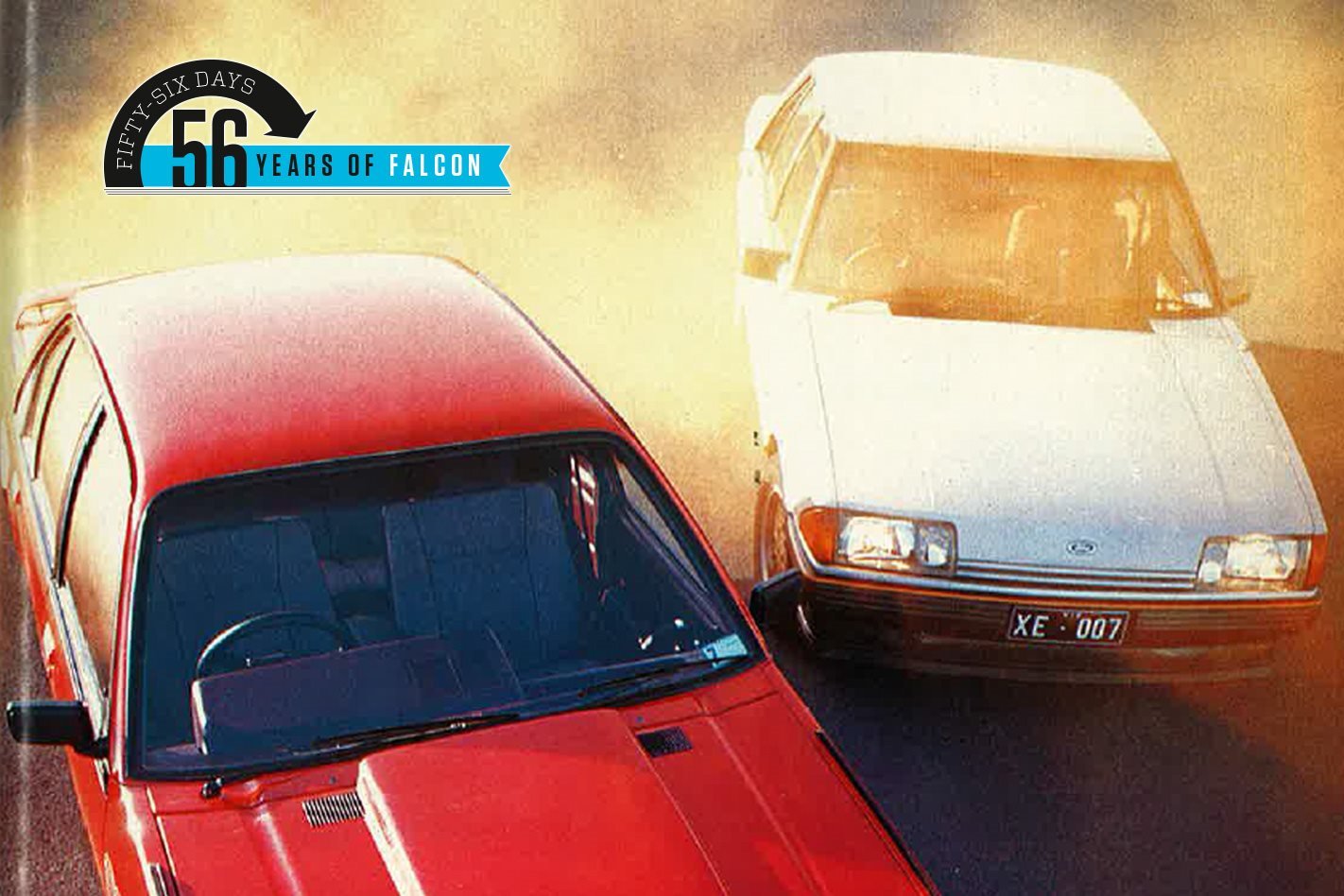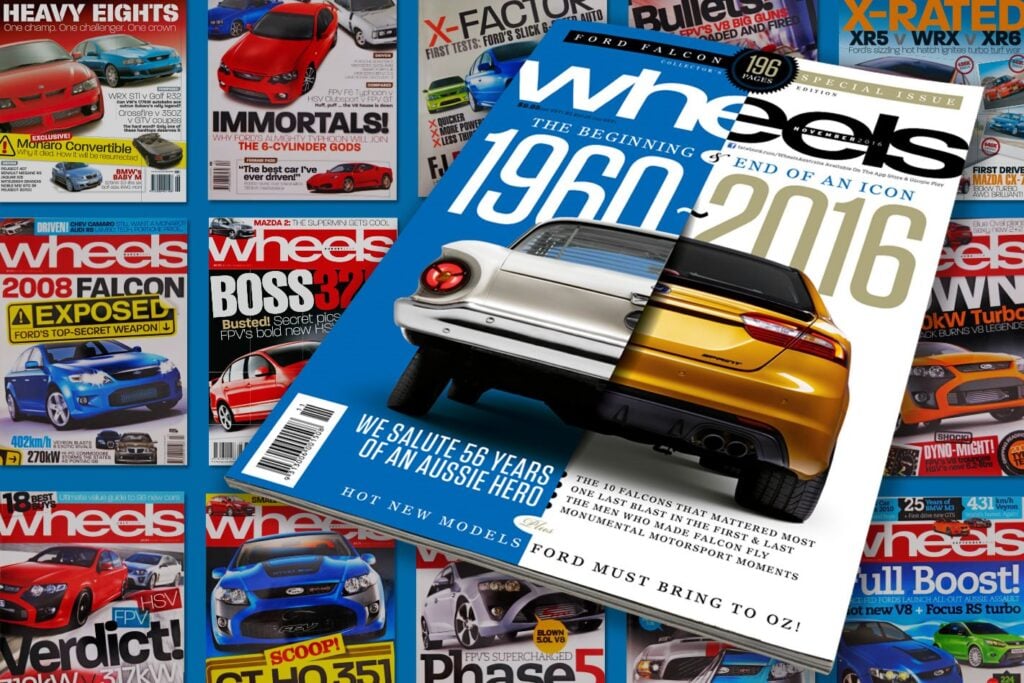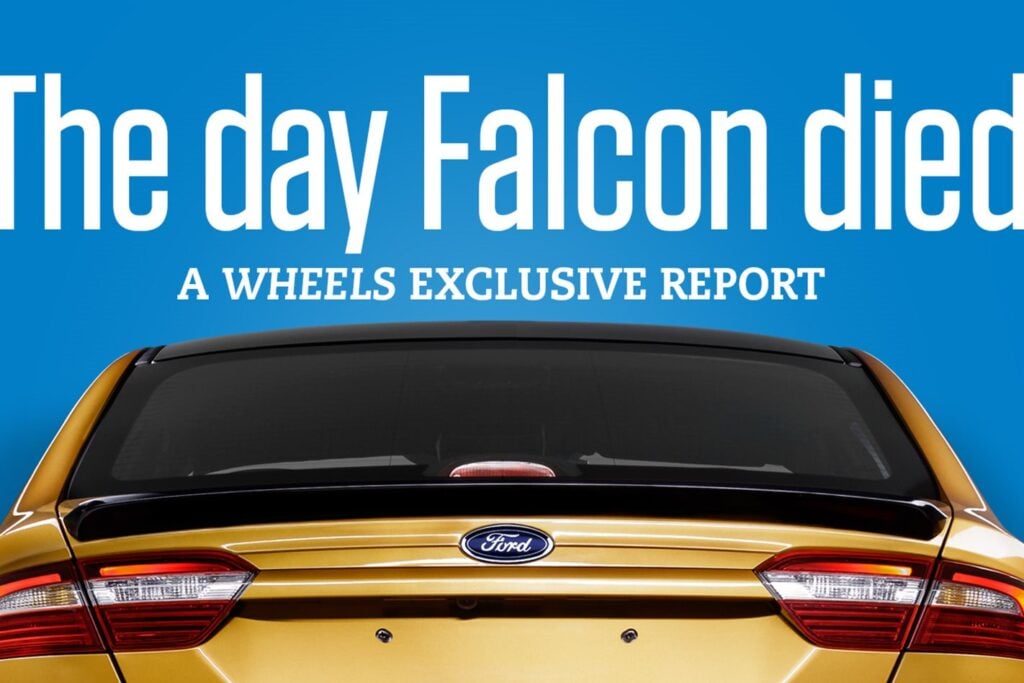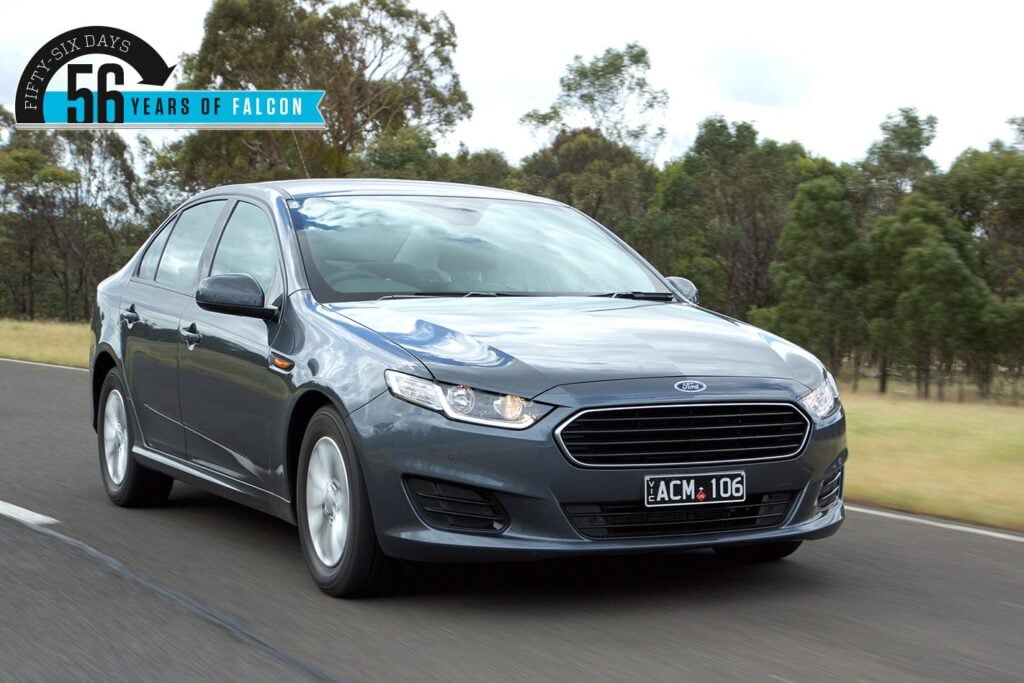First published in the April 1982 issue of Wheels magazine, Australia’s best car mag since 1953.
Commodore SS Group Three meets Falcon 5.8 ESP. Long live the bent eight!
AMONG THE Commodore SSs which crowd Leveson St, North Melbourne, outside unprepossessing premises signed HDT Special Vehicles, Peter Brock’s own car looks quietly superior. It’s red like all the other SSs parked in a double line down the centre of this wide Melbourne street, but there’s something about its bulges and wheels and flashes of black on the front guards that suggests it has extra to offer; more even than the Commodore HDT, a couple of which lurk nearby, heavily suggestive with their rounded wheelarch extensions and louder striping and badgework, but lacking the red car’s low-key assurance. You know this is the car long before Peter’s brother, Phil, comes out to hand over the keys.
There’s a label attached to the keyring with the handwritten scrawl: Peter’s car. You would think there a remote chance of Phil Brock, affectionately known as Splitpin, being Peter’s distant cousin, let alone brother. He’s much taller than the Bathurst champion and has what a diplomat would describe as a face of character. He sees but ignores the silver ESP Falcon parked nearby, the car that had brought us to Melbourne the night before as easily as only 400 Nm of torque and a four-speed can, and asks if I can try the special stereo gear fitted to Peter’s SS, if I get the chance. It’s $1400 worth he says, in a tone that half suggests it might be a little excessive. I ask if the 14.6 second 400 m time is fair dinkum. He says it is. I forget to ask how many revs you have to use to get that.
Later, at Mangalore airstrip north-west of Seymour, the five-litre V8 engine shatters the cemetery quiet with a moderate 5000 rpm, taking Peter Brock‘s red car, the first of the SS Group Threes, past the 400 m mark in 15.1 seconds. Disappointment is marginal.
WE LEAVE the outskirts of Sydney at 3pm and get to Albury at 8pm, the 5.8 litre four-speed Falcon ESP, heading for Melbourne to do battle with the Group Three in our own mini-James Hardie , lapping up a pleasingly deserted Hume: 523 km in five hours on one tank of petrol (just) at 6.4 km/L (18 mpg) with four big adults aboard and a heap of luggage. The journey could have been arranged by Ford PR as an example of a Falcon’s capabilities, for the car is suited to the task perfectly. I drive the first stint to Albury; it’s easy. I think we stopped once at a red light and there were three gearchanges; 415 Nm of torque did the work, not me. It is the first Falcon I have come to respect.
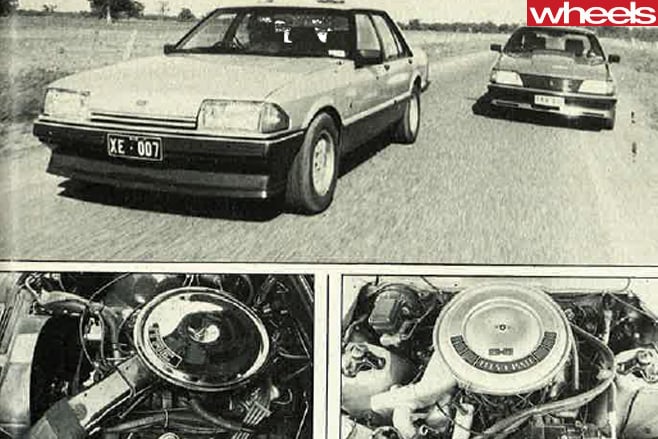
In a time, rapidly reaching Australia, of turbocharged fours and injected sixes it’s a surprise we have available in this country any V8 of 5.8-litre capacity, and, of course, Ford’s all-iron lump isn’t long for this world. Production stopped in mid-82 and, it has been confirmed, won’t be started again. Availability for several months now has been on and off as the special stock set up by Ford, originally to last three years, diminished. Ford has kept a low profile on the 5.8, and those who didn’t sift through April ’82’s launch material on the XE Falcon range could be forgiven for thinking it was dead already, the little information there was being well buried (the 5.8, despite improvements to its economy, hardly fitted into Ford’s picture of the six-cylinder XEs with their significantly slaked thirst). The 5.8 is probably a cause of embarrassment for Ford in the months before its fuel-injection sixes arrive: demand is still high – the police still want it, for instance – and the cupboard is just about bare.
Socially irresponsible a 5.8litre engine may be to some, but equally there’s no doubt many, many others will regard a switch from a V8 to a six, however much power it has, a difficult-to-accept comedown.
Still, Ford public relations department, under pressure from motoring journalists, made available a 5.8 four-speed test car towards the end of ’82; it probably would have preferred not to have done so, for from Ford’s point of view now cannot be the time for column inches praising something as supposedly inefficient as a 5.8 when around the corner lurks technology just itching to thrust Australia’s most popular big car into a new era of efficiency.
The test car, traditionally numbered 007 with the prefix XE for the new model, is a Fairmont Ghia with the European Sports Pack; only the boys in blue are allowed their 5.8 four-speed without the Ghia’s performance-sapping embellishments. There are a few of those too, for the Fairmont Ghia is not underprivileged in the equipment stakes.
The ESP option, available with other drivetrains adds a deep front airdam, gold-coloured alloy wheels and Scheel bucket seats, while the XE Falcon’s newly coil-sprung and Watts link-located live axle suspension system gets Bilstein gas dampers, a 24 mm instead of a 22 mm front anti-roll bar, increased-rate coils and a lower ride height, a reset rear end and changed geometry for the power-assisted recirculating ball steering. Brakes are servoed discs back and front, a limited slip differential is used and the gearbox is a close-ratio four-speeder from Borg Warner. The price of all this, if you can find someone to take your cheque, is $18,555.
GMH, too, recognises that big-capacity V8s are not in keeping with the image a forward -looking car-maker wants to project. But unlike Ford, which converted its Geelong V8 line to make the new four-cylinder engines for the Telstar, GMH, faced with a similar production dilemma with the Camira’s Camtech engine, chose not to sacrifice its bent eights. And today retains its V8 line, albeit today it’s much more slow-moving than in the heyday of the V8 musclecar.
No one can say how long the General’s V8s will last: an optimistic Phil Brock says the SS’s five-litre – and the 4.2, which at HDT’s hands benefits from a greater percentage power boost than the five – has given results which must guarantee continued production by GMH. Certainly that production has recently been upped (the decision was apparently taken before the favourable Bnthurst result): to the original run of 500 SSs to be built by the end of October we can add an extra 200 by Christmas and another 700 between February and March ’83, making a planned total of 1400 cars in seven months. Phil Brock says 800 of these will have the five-litre.
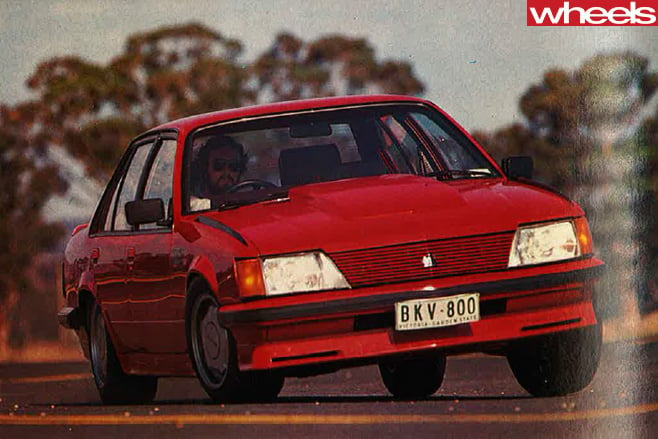
HDT Special Vehicles, acting as an outside supplier of GMH, offers three levels of development on this basic SS, regarded as dealer/purchaser options. Instead of being shipped to the dealers those cars requiring the Group One, Two or Three treatment are taken direct to Leveson St from the factory. The three levels, with nil changes and additions tested, ADR’ed and warranted by GMH, are priced separately for addition to the SS’s base price, which is $13,3S5. Group One adds to the SS the HDT suspension kit – reset and rerated coil springs, a bigger front and smaller rear anti-roll bar, henvy duty top strut bearing mounts, Bilstein front strut inserts and Bilstein rear dampers and revised geometry – a chromed and bigger capacity air cleaner, heavy duty brake master cylinder and Uniroyal tyres. The body gets a ‘Group One’ decal, and there are more decals inside along with sports steering wheel, HDT gearshift knob and footrest. Group One costs $1995.
Group Two, for $3250 on top of your SS, has everything from the Group One car with in addition blueprinted cylinder heads, chrome rocker covers and other bits, a gas-flowed inlet manifold and fuel anti-vapourisation kit. The body gets the black guard-mounted ‘aero fences’ and a rear deck spoiler. Power in this car is claimed to be 153 kW, 50 kW up on the standard 4.2.
The Group Three 4.2 costs $4750 and with it you get everything mentioned so far plus a blueprinted ignition system – power is similar to the Group Two’s at 153 kW – 15 inch Irmscher alloy wheels with 225×60 Uniroyals and, on the body, a front airdam and extended sills. Optional is a bonnet scoop which is the only other body mod available, although you can have the HDT’s flares to special order. Like the HDT’s styling mods, the SS’s visual revamp is the work of GMH’s design chief Leo Pruneau (who, incidentally, is presently busy putting the final touches to the HDT Camira).
Five and a half grand gets you the Group Three SS with the five-litre engine; the big V8 only being available with the Group Three pack (Phil Brock says candidly the lesser SSs cannot adequately handle the five’s power). An important change over the 4.2 is in the use of harder rear suspension bushes. The bonnet scoop is standard. The big V8 gets the similar treatment to the 4.2 – in simple terms, a thorough ‘head job’ beloved of the custom car fraternity: big-valve heads, gas flowed inlet manifold and blueprinted ignition system with, waiting in the wings for an AOR clean bill of health, exhaust headers. Power of this ultimate Commodore goes from the standard five-litre’s 132 kW at 5000 rpm and 364 Nm at 3000 rpm to 180 kW at 4 750 and 430 Nm of torque at 3500.
A heavier clutch pressure plate is fitted, the brakes- all disc, of course like the Ford Falcon– benefit from Castrol GT LMA fluid and a bigger master cylinder, and the steering, too, is remarkably little changed, though there is a discernible difference in feel thanks to the revised front end geometry (to reduce the standard car’s maximum negative camber and increase positive castor). Like the Falcon, too, the Group Three five- litre, like all SSs, comes with a limited slip diff running a 3.08 ratio (significantly taller than the equivalently tyred HDT with a 3.36. but still a little shorter than the very long-legged Falcon’s 2.92) and it uses GMH’s own M21 close-ratio four-speed. Tyres on both Falcon and Commodore are Uniroyal Wildcat ER60H 15s.
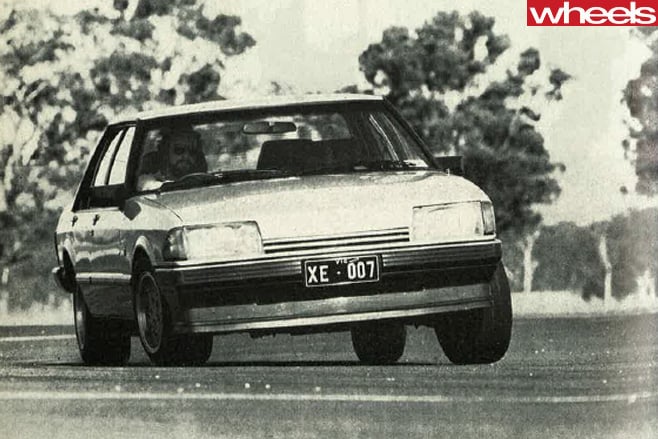
MANGALORE IS not what you’d call a busy airport, just as well for us of course for as a dragstrip handy to Melbourne it is a godsend. The blokes who watch over the place never seem to have much to do and today they are sitting in a ute alongside the main runway, closed to aircraft with two giant crosses, watching us line up the ESP and the Group Three. It is a frenetic figures-getting session. The surface is very grippy and the traction of the cars so good it is difficult to get them off the line without bogging the engine. Many runs are abandoned as engines, clutches and tempers get hot.
We do the in-gears acceleration times and the stopwatches click like I’ve never heard them click before: both cars are despatching the 30 km/h increments in as little as three seconds in second gear; even in fourth the Commodore is taking less than five seconds for many speed rises, and McCarthy’s practised hands work the watches like there is no tomorrow, concentrating hard in the Commodore especially to allow for the most stupidly illogical speedometer error.
A concerted effort results at last in several good 400 m runs and we see 15.1 seconds for the Group Three car and 16.1 for the Falcon ESP. We are not game to see more revs to try to get into the 14s with the Commodore, although perhaps it is possible as HDT claims. We do, however, run a nought to 160 km/h time in the Holden Commodore (by this time worsening carburetion troubles with the Falcon have sidelined the car). Any car that can reach a true 160 from standstill in around 20 seconds is a strong performer, and the Commodore does it easily in 17.4. The last car with this type of performance we drove was the Alfa GTV Turbodelta (WHEELS September) which, rightly, we called shatteringly quick. The Commodore Group Three is afull five seconds faster to 160 …
Look at the figures; only very rarely do motoring magazines anywhere in the world have the opportunity of publishing the times we quote for the Falcon ESP and the Holden Commodore Group Three, and if they did the figures would certainly be associated with cars of enormous price tags or dubious reliability. “These two cars,” we tell the airport blokes still watching us from their ute after we’d finished taking the figures, “are very probably the best sporting sedans for the money anywhere in the world.” They don’t look terribly impressed.
FROM MANGALORE we drive to Shepparton and the two cars lope along easily, their huge reserves of torque pulling their tall fourth gears impossibly easily. With each car’s ultimate performance locked in our memories we find there no reason to speed; we know we can blow off anything that comes along and in many ways that’s more satisfying than having to prove it. A fast-moving BMW Seven Series overtakes us and I consider slipping the SS into second – we are doing about 90 km/h- for a two-second burst and then a snapshift into third, a gear that would reel in that BM, however hard the driver was trying, with ease.
Instead, later down the road, there’s a flat, straight and empty stretch and there the SS gets its head; 5000 rpm in second, third and fourth- 105, 139 and 192 km/h corrected, though now, spearing down this deserted road with the tacho needle evenly on five grand and the engine straining at the leash, the speedo is registering 200, its last calibration. And, praise be, it was push-you-back-in-the-seat stuff all the way there, without a surge or a stutter. And now, this fiery V8 howling for more, I have to lift off heavily to prevent the needle swinging into the red. How dare Phil Brock tell me when we return the car that the engine can go briefly to five-eight! It would have pulled the revs, of that I’m sure, taking the SS into the rarefied performance world past 220 km/h or 135 mph.
Playing things strictly by the book, the Falcon has the higher top speed, 194 km/h at fewer revs than the Commodore – the Ford’s red line is 4800 and feels it – but in a longer-striding (40.4 instead of 38.3 km/h/1000 rpm) fourth gear. The Falcon takes twice or three times the length of road to get to its top speed, which is still mightily accelerative but not in the Commodore’s neck-snapping class.
Past 160 km/h there’s a noticeable tailing off of urge as weight and wind resistance sap the reserves.
ln the lower ratios similar maxima are available except in third which is usefully longer than the Commodore’s; in any car but the Group Three SS there would be a hole between third and fourth.
Big capacity V8s with four-speeds, specially the American-derived variety, are not known for their snap-action gearshifts, light clutches or quiet cogs and neither car breaks with the tradition.
Except for the Falcon’s gearshift: it’s a delight to use. The lever is short and has a firm, German-type feel to it in its well-defined, short travel gate. The clutch pedal, too, though heavier than the Commodore’s (and tiringly heavy in traffic) works progressively and has a short travel which coordinates much better with the gearshift, specially since the accelerator is well-placed for easy heel and toeing. With a longer, floppier and notchier gearlever, coupled with a longer-travel clutch, the Commodore lacks the Falcon’s gear-changing finesse. Both have plenty of truck-like gear whine in second and third ratios, the Ford the most.
Both cars are good to drive and ride in, when going quietly being staggeringly similar to their cooking-model brothers.
There’s more bump-thump from the bigger tyres (though generally the Uniroyals are very quiet, apart from an annoying tendency to squeal in the Falcon) and the rides of both cars are firmer than normaI but certainly not uncomfortably so: at low speeds the Falcon, despite some unnecessary body movement, copes smoothly with the type of rough surfaces that give a hint of jiggling in the Commodore.
Through traffic , whether you’re seated on the plain-looking and low-mounted driver’s seat in the Holden or on the firmer, better bolstered and positioned Scheel bucket in the Ford, the cars display impeccable manners, sacrificing nothing – not even noise suppression, which in both is excellent – to ordinary Falcons and Commodores. Only the solid torque available and the 200 km/h calibrated speedos (with Ford scoring the points for clarity of dash design) suggest to the unknowing that these cars are designed for doing something more than pottering to the shops and back.
They are designed for going very long distances very quickly and both do the job superbly. The Falcon does it quietly, softly and lightly – too lightly, for the steering, although good at the straight-ahead and accurate, is too light for comfort at the ESP’s potential cruising speeds. The Commodore does the same job significantly faster, and with crispness and accuracy. From that you will gather that one’s a cruiser and one’s a racer but in the Group Three SS’s case the roles are completely interchangeable for it is certainly as good a cruiser as the Falcon.
The Falcon 5.8 can’t slip as easily into the role the Commodore is so good at. Apart from the steering lightness, the ride is patently underdamped at the front end and this shows up in high-speed wallowing over bumps and, on occasion as we found, a disconcerting tendency to find the bump stops. The Falcon also twitches on bumps mid-corner, heightening the often present, but never excessive, understeer.
The engine and brakes – superbly powerful and progressive – are two steps ahead of the chassis in being able to provide ultra-fast cross country times. Stiffer dampers would, we presume, harm the low-speed ride too much, a shame but then if there has to be a compromise probably the Falcon has the right balance, specially since it is such a gentle, predictable car to handle.
Another magazine which shall remain nameless (Modern Motor) recently said the 5.8 ESP was a difficult car to drive quickly. It is nothing of the sort, for though the car may have deficiencies, it certainly has no vices. Pushed very hard, its handling is almost graceful, Jaguar-style. Understeer and oversteer are slow-motion actions which, even when deliberately provoked in tight corners as they can easily be, require minimal correction. For all its weight and bulk and power this Falcon feels tame and – as best shown in high-speed cornering on smooth roads – well balanced. Whatever Dick Johnson may say about his racing Falcon, there is no viciousness in the road-going ESP.
The Group Three SS you tame. You must tame it to get the rewards, and at first it’s an intimidating car. Peering up and out over the dash to the big air scoop on the bonnet, practising the clutch and gearchange, not as well synchronised as the Falcon’s, remember, all these things take acclimatisation and it’s best to be sure before you unleash all the performance . At first that performance is simply frightening; this car in the wrong hands doesn’t bear thinking about. But for the luxury trim, the quietness and suppleness of the ride, you could easily think you’d climbed aboard 05 by mistake.
The handling, too, seems to be uncompromised in its bias towards performance. As in any V8 Commodore, weight transfer is noticeable in corners, and at first this buttock-contracting lurching feel from the rear is disconcerting. But the steering, through a lovely, thick-rimmed wheel is ideally weighted and accurate, is so damn good.
The engine is so responsive, and the brakes are so reassuring … surely this car has no vices? Indeed, the rear-end heaviness is just a feeling, a premature warning for the unambitious. There is nothing beyond it to surprise the driver: nothing but a new bite from the tyres as the weight settles and the body flattens and as full noise goes on to take the car around – neutrally, in a four-wheel drift or in a tailslide. The driver has the choice. Bumps are taken in the car’s stride and the damping provides a standard of high-speed control the equal of many exotics, and better than some because there is never any harshness. The Group Three SS starts where the Falcon ESP stops.
IF THE Falcon gave me a drive to respect – and would do again, on the homeward run to Sydney – the Group Three SS provided the experiences to remember. Going up through the gearbox and feeling the wall of torque hit us in the back as the clutch is released, holding a powerslide for 50 m around our makeshift corner at Mangillore, revelling in the balance of the car. Spearing fast along the roads going to Eildon, straightening a series of chicanes with an easy flexing of the wrists on that lovely leather wheel. Braking deep and late into corners and accelerating out to 5000 rpm just to hear the engine’s heathy wail, never intrusive but always satisfyingly audible.
It’s a racing car for the road, you say? No, the Group Three SS is much, much more than that. It’s a sports sedan, a blend of accomplishment and accommodation, or purpose and practicality. And if it’s not the best sports sedan for the money in the world, I’ll stand rooted.
Check out Wheels Archive online now for other great Ford Falcon features and more from decades past!
Simply log in here using your existing MagShop account or create a FREE account and select this article from the homepage.
Don’t have a MagShop account?

Have a MagShop account?


